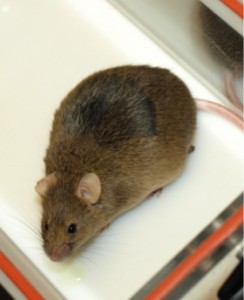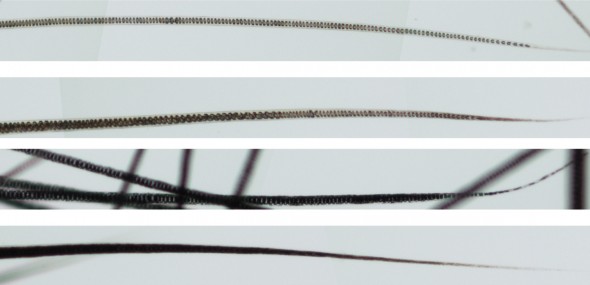
Paint-On GMOs Could Create Cattle, Dogs with Custom Fur
Imagine a Dalmatian covered with hearts instead of spots. Or a black cow whose rear end had a perfectly etched bar code of white fur.
These things are possible, according to AgGenetics, a Nashville, Tennessee, startup now raising $5 million on AgFunder, a crowdfunding site for agricultural technology projects.
The company’s commercial objective is to use genetic engineering to create a heat-tolerant version of Angus beef cattle whose coats are entirely white instead of black or dark red, as they normally are, so the animals can thrive in the hot tropics.
Along the way to white Angus, however, the small company’s founder, James West, came up with something that’s truly bizarre. He figured out he could genetically “paint” different hair color onto animals.
And he has brown mice covered with black squares, dots, and straight lines to prove it.
 A mouse whose genome has been altered so that applying an enzyme to its skin changes its fur color permanently. Here a square of dark fur was added.
A mouse whose genome has been altered so that applying an enzyme to its skin changes its fur color permanently. Here a square of dark fur was added.
People have changed the color of animals with genetic engineering before. But a patent application filed by AgGenetics boasts that it is the first to figure out how to create “customizable color or patterns in the skin or fur of animal species.” The document, available here, is a fascinating look at just one of the curious tricks that gene modification is going to allow in animals, although perhaps not the most important. West, a professor who runs a 20-person lab at Vanderbilt University, is an expert at making genetically modified mice that mimic human diseases, such as rodents with pulmonary arterial hypertension.
West says he hit on the paint-on GMO idea in an idle moment. “I was just fiddling with technology. And I made mice where you could permanently change their coat color,” he says.
Not everyone thinks coloring-book animals are a worthwhile endeavor. “This is dumb,” says Scott Fahrenkrug, the founder of Recombinetics, a company engineering cattle using new gene-editing techniques. His company managed to make dairy cows without horns, which they usually have. He says if you want to put a logo on the side of a dog it might be easier to use hair dye.
West used a workhorse genetic-engineering tool called Cre-Lox, originally invented by DuPont. It’s a genetic device that adds a gene to an animal’s DNA, but keeps it in a kind of genetic lockbox. Only when it comes in contact with a special enzyme, Cre, does the gene swing into action.
Mice labs use it all the time to turn genes on or off in specific tissues or organs. But West set up the system to express a gene that makes hair black. The twist was to then apply the trigger enzyme with a brush, or as a tattoo, from the outside. “I became a prison artist,” says West, who used a needle to prick the enzyme into the mice’s hair follicles after shaving off a patch of hair. West says it will be possible to make patterns of any color that mammals’ bodies naturally make use of, which actually isn’t that many: just white, red, yellow, and black.
 A microscopic image shows hairs of a single mouse genetically engineered to produce either lighter or darker pigment.
A microscopic image shows hairs of a single mouse genetically engineered to produce either lighter or darker pigment.
This isn’t going to be a new way of tattooing people with a skull or tribal band. That’s because you’d have to be born genetically engineered with the Cre-Lox system inside your cells. But West’s patent has plenty of other species in mind, including dogs, cats, horses, weasels, and chinchillas.
The idea to start AgGenetics began when West approached Warren Gill, then a department chairman at Middle Tennessee State University, where there’s a big beef herd. West showed Gill a photoshopped image of a black cow with a bar code made out of white fur.
Gill, who has owned a cattle ranch for 40 years, said no one would be interested in a bar-coded cow. But he did wonder: if you could paint a white line on a cow, could you just paint the whole cow white?
In fact, that’s easier to do, and potentially more valuable, too. Angus are high-performance beef animals. On the same patch of grass, they’ll put on twice as much muscle as other breeds. But all of them are black and they overheat in hot climates. A white coat is reflective and only absorbs about half as much sunlight. With a white coat, Angus could be raised in places in the tropics, like Brazil, where cattle-ranching is expanding.
Gill left Middle Tennessee State University to become CEO of AgGenetics, which is now trying to permanently engineer the genetic instructions for white hair into Angus cattle (rather than using the painting technique) and also give the animals shorter hair. A first attempt at creating these animals wasn’t successful—they didn’t make it to birth. But the company is trying again, says West.

Leave a Reply